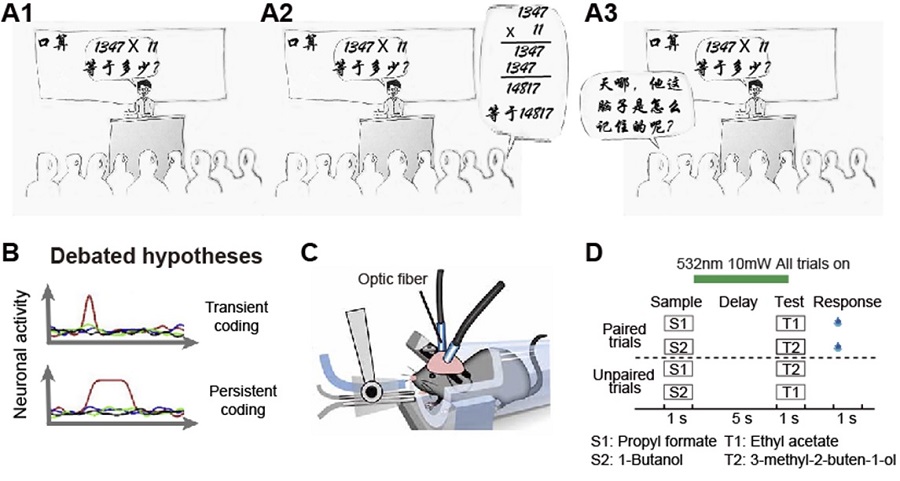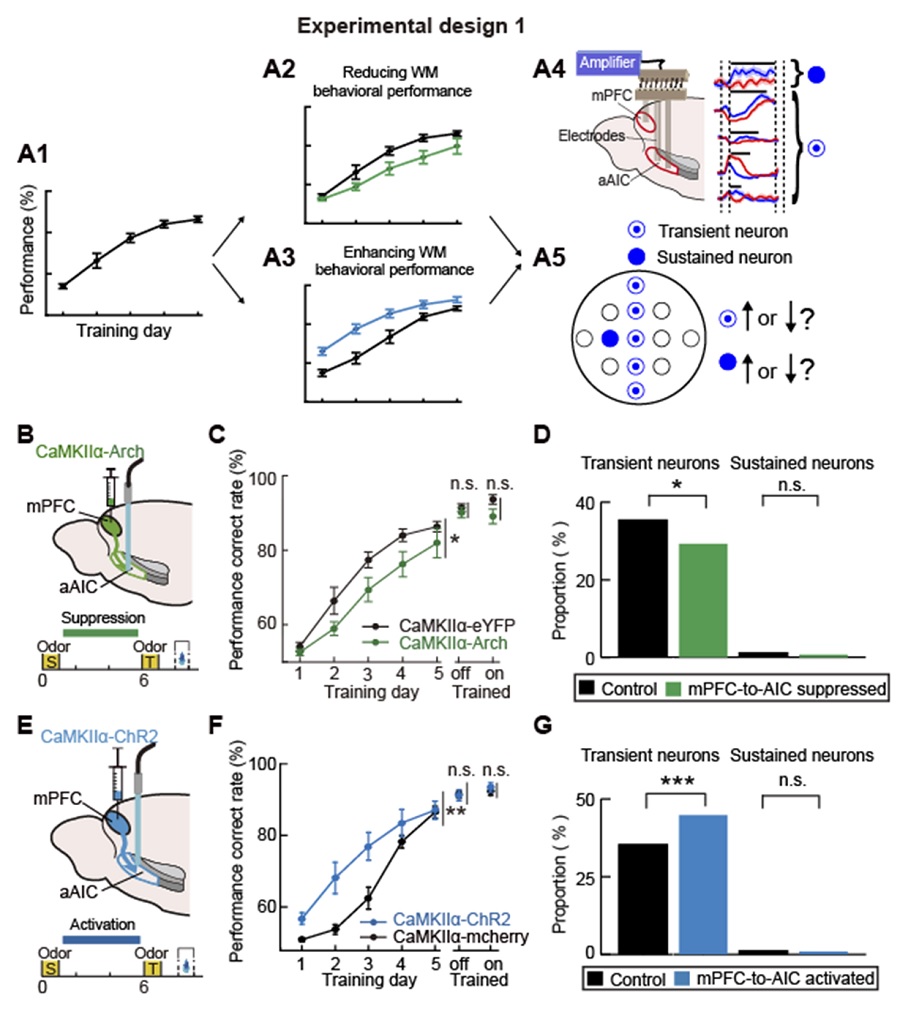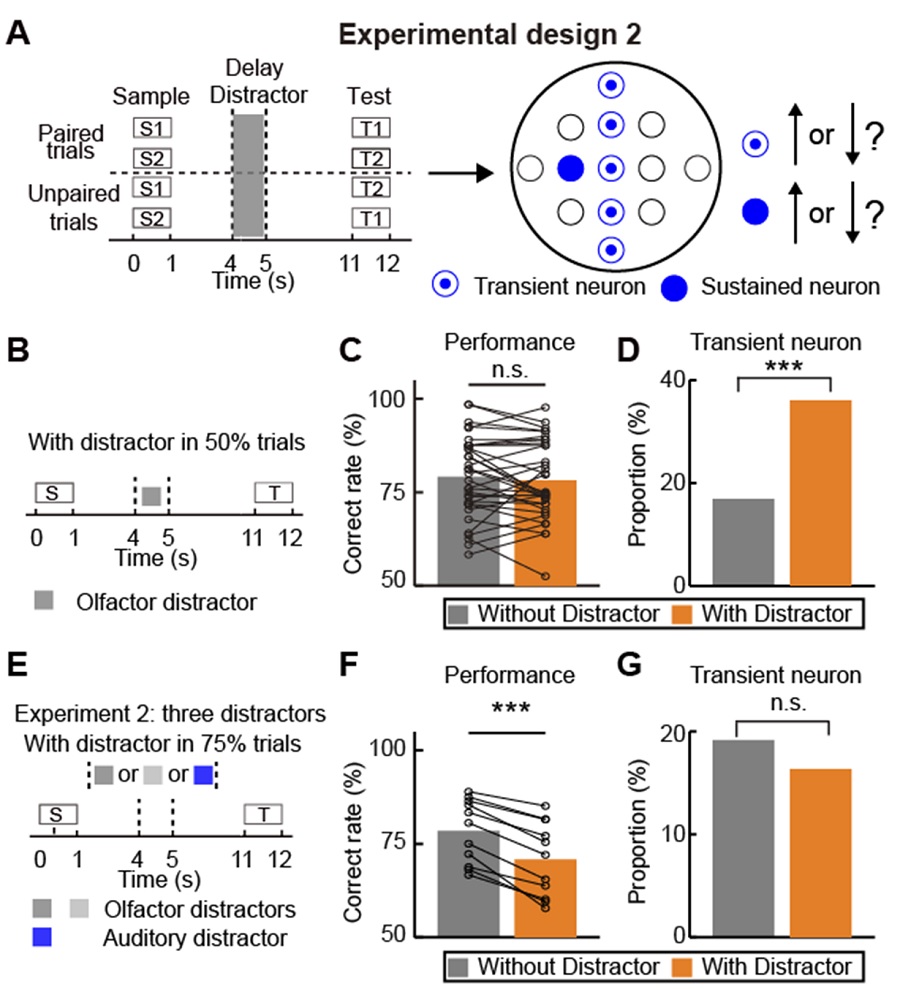Time:2020-03-05
A recent study published in Neuron provided new evidence about the neural mechanisms of active information maintenance in working memory. The work was performed by the researchers in Dr. LI Chengyu’s Lab at the Center for Excellence in Brain Science and Intelligence Technology, Institute of Neuroscience, State Key Laboratory of Neuroscience, Chinese Academy of Sciences.
Working memory (WM) refers to the ability of the brain to temporally store and manipulate information for a period of seconds. It is the basis of our daily life (Figure 1A) and many other human-unique cognitive functions, such as reading, thinking and language acquisition, etc. How the brain temporally stores information? After about half century of research, two debated hypotheses were proposed as the neural mechanisms (Figure 1B): 1. Persistent coding; 2. Transient coding. Limited by the possible technical accesses, previous studies supporting these two hypotheses draw their conclusions mainly based on correlational data (e.g. extracellular recording), without elaborate perturbations of behaviors. Before the current study, no published work directly investigated the relationship between the modulations of WM behavioral performance and the two debated hypotheses. In this study, the researchers tried to tackle the debate, by combining elaborate optogenetic perturbations and extracellular recordings.

Figure 1 | (A1-A2) An example of the utility of WM in daily life and the scientific question to be addressed in the study(A3).(B) Two debated hypotheses about the neural mechanisms for information maintenance in WM.(C)The behavioral training set-ups for head-fixed mice.(D)An olfactory WM behavioral paradigm. (Image by CEBSIT)
To solve this debate, the researchers developed an olfactory WM behavioral paradigm (Figure 1C, 1D) and an efficient behavioral training pipeline (Figure 2A1, fast learning and small variations). Theoretically, they designed multiple lines of experiments (Figure 2A1-A5) to evaluate the hypotheses. The underlying logic was as follows: if the transient (or persistent) coding was the dominant controller for WM information maintenance, the corresponding neural signatures should show parallel modulations accompanying the modulations in WM behavioral performance.
Based on multiple optogenetics experiments, they narrowed down the critical role of agranular insular cortex(aAIC) in WM information maintenance (Ref. to the original paper), rather than other WM performance-related functions, such as perception, modulation of motivation and motor control, etc. Furthermore, optogeneticallly suppressing the axon terminals (Figure 2B) from medial prefrontal cortex (mPFC)to aAIC (denoted as mPFC-to-aAIC) significantly down-regulated the WM behavioral performance (Figure 2C). A parallel modulation in the proportion of transient neurons, but not sustained neurons, was observed (Figure 2D). On the contrary, activating the mPFC-to-aAIC pathway (Figure 2E) could consistently up-regulate both the WM behavioral performance (Figure 2F) and the proportion of transient neurons (Figure 2G). Thus, the results indicated that transient neurons, but not sustained neurons, were the dominant controller for WM behavioral performance. Therefore, transient coding was the preferred working mechanism for WM information maintenance.

Figure2 | (A1-A5) Experimental design. (A4)The definitions of transient and sustained neurons. Red and blue lines indicated the firing rates following different sample odors (shown in Figure 1D). (B) Schematics of optogenetic suppression of mPFC-to-aAIC pathway.(C)Behavioral performance following optogenetic perturbations of mPFC-to-aAIC pathway.(D)Proportions of transient/sustained neurons following optogenetic suppression of mPFC-to-aAIC pathway.(E-G)The same as(B-D) for the activation experiments. (Image by CEBSIT)
To confirm the conclusion, the investigators tried to address this debate from another perspective. Efficient resistance to distraction was a prerequisite for successful WM information maintenance. Whether transient or sustained neurons were responsible for protecting WM information under distraction was unrevealed (Figure 3A). To examine it, researchers imposed two sets of distractors (Figure 3B and 3E, with lower and higher demands, respectively) during WM delay period. Significantly increased proportion of transient neurons (Figure 3D) was concurrently observed with successful resistance (Figure 3C) to lower demanding distractor (Figure 3B), but not in the more demanding distraction condition (Figures 3E-3G). Besides, no significant modulations of sustained neurons were observed under any conditions. The results also indicated that transient but not sustained neurons were associated with successful WM information maintenance under distraction.

Figure 3 | (A) Experimental design. (B) Behavioral paradigm with single distractor during delay. (C)Distraction effects on behavioral performance. (D)Distraction effects on the proportion of transient neurons. (E-G)The same as (B-D) for experiment 2 (with multiple possible distractors). (Image by CEBSIT)
The above two cohorts of experiments strongly supported the critical role of transient coding scheme, but not persistent coding scheme, in WM information maintenance under the current experimental conditions.
This work entitled "Transient delay-period activity of agranular insular cortex controls working memory maintenance in learning novel tasks " was published online in Neuron on March 5th. ZHU Jia and CHENG Qi contributed equally as the first authors. Dr. LI Chengyu was the corresponding author.
Contact:
LI Chengyu
Center for Excellence in Brain Science and Intelligence Technology, Institute of Neuroscience, Chinese Academy of Sciences
Email:tonylicy@ion.ac.cn
 附件下载:
附件下载: